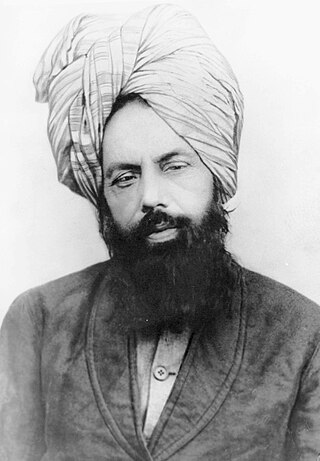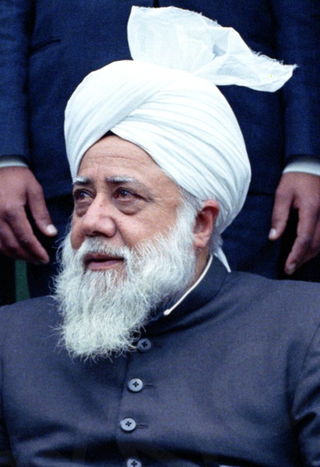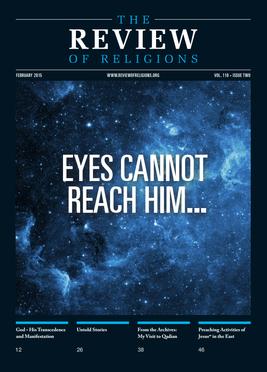
Mirza Ghulam Ahmad was an Indian religious leader and the founder of the Ahmadiyya movement in Islam. He claimed to have been divinely appointed as the promised Messiah and Mahdī—which is the metaphorical second-coming of Jesus (mathīl-iʿIsā), in fulfillment of the Islamic prophecies regarding the end times, as well as the Mujaddid of the 14th Islamic century.

Ahmadiyya Islam considers Jesus (ʿĪsā) as a mortal man, entirely human, and a prophet of God born to the Virgin Mary (Maryam). Jesus is understood to have survived the crucifixion based on the account of the canonical Gospels, the Qurʾān, hadith literature, and revelations to Mirza Ghulam Ahmad. Having delivered his message to the Israelites in Judea, Jesus is understood to have emigrated eastward to escape persecution from Judea and to have further spread his message to the Lost Tribes of Israel. In Ahmadiyya Islam, Jesus is thought to have died a natural death in India. Jesus lived to old age and later died in Srinagar, Kashmir, and his tomb is presently located at the Roza Bal shrine.

The Ahmadiyya Caliphate is a non-political caliphate established on May 27, 1908, following the death of Mirza Ghulam Ahmad, the founder of the Ahmadiyya Muslim Community, who claimed to be a Prophet, a Messenger, the promised Messiah and Mahdi, the expected redeemer awaited by Muslims. It is believed by Ahmadis to be the re-establishment of the Rashidun Caliphate that commenced following the death of the Islamic prophet Muhammad. The caliphs are entitled Khalīfatul Masīh, sometimes simply referred to as Khalifa. The caliph is the elected spiritual and organizational leader of the worldwide Ahmadiyya Muslim Community and is the successor of Ghulam Ahmad. He is believed by the Community to be divinely ordained and is also referred to by its members as Amir al-Mu'minin and Imam Jama'at. The 5th and current Caliph of the Messiah of the Ahmadiyya Community is Mirza Masroor Ahmad.

Al-Barāhīn al-Ahmadīyyah 'alā Haqīqatu Kitāb Allāh al-Qur'ān wa'n-Nabūwwatu al-Muhammadīyyah is a five-part book written by Mirza Ghulam Ahmad, the founder of the Ahmadiyya Movement. The first two parts were published in 1880 CE, the third volume was published in 1882, the fourth volume in 1884 and the fifth volume in 1905. In writing the book, Ghulam Ahmad sought to rejuvenate Islam by arguing for the validity of its principles and vindicating its teachings in response to Christian and Hindu polemics against Islam as well as atheistic philosophies. In this context, a significant portion of the subject matter of the book is dedicated to the defence of Islam as a whole against the criticism of Muhammad, the Qur'an and Islam that was raised in the 18th and 19th centuries predominantly by Christian missionaries and Hindu revivalists.

Mirza Tahir Ahmad was the fourth caliph and the head of the worldwide Ahmadiyya Muslim Community. He was elected as the fourth successor of the founder of the community, Mirza Ghulam Ahmad. He was elected on 10 June 1982, the day after the death of his predecessor, Mirza Nasir Ahmad.

Mirza Nasir Ahmad was the third Caliph of the Ahmadiyya Muslim Community. He was elected as the third successor of Mirza Ghulam Ahmad on 8 November 1965, the day after the death of his predecessor and father, Mirza Basheer-ud-Din Mahmood Ahmad.

Mirza Basheer-ud-Din Mahmood Ahmad was the second caliph, leader of the worldwide Ahmadiyya Muslim Community and the eldest son of Mirza Ghulam Ahmad from his second wife, Nusrat Jahan Begum. He was elected as the second successor of Mirza Ghulam Ahmad on 14 March 1914 at the age of 25, the day after the death of his predecessor Hakim Nur-ud-Din.

Hakeem Noor-ud-Din was a close companion of Mirza Ghulam Ahmad, the founder of the Ahmadiyya Movement, and his first successor and first Ahmadiyya caliph since 27 May 1908.

Basharat Ahmad, a member of the Lahore Ahmadiyya Movement, was the author of numerous publications about Islam and the Ahmadiyya movement. He was the father of Naseer Ahmad Faruqui and the father in law of Maulana Mohammad Ali.

Khwaja Kamal-ud-Din was a prominent figure of the early Ahmadiyya movement and the author of numerous works about Islam.

In Ahmadiyya theology, the view on the Prophets of God differs significantly from Mainstream Islam. The main difference centres on the Quranic term Khatam an-Nabiyyin with reference to Muhammad which is understood by Ahmadis in terms of perfection and testification of prophethood instead of chronological finality. Accordingly, Muhammad is held to be the last prophet to deliver a religious law to humanity in the form of the Quran whose teachings embody a perfected and universal message. Although, in principle, prophets can appear within Islam but they must be non-lawbearing prophets dependent upon the sharia of Muhammad. Their prophethood is reflective of that of Muhammad, that is, within his Seal; and their role is merely that of reviving and purifying the faith. They cannot be prophets in their own right and cannot change, add to or subtract from the religious law of Islam. As such, Ahmadis, regard their founder Mirza Ghulam Ahmad (1835–1908) as a subordinate prophet who appeared as the promised Messiah and Mahdi in accordance with Islam's eschatological prophecies. In contrast to mainstream Muslims who believe Jesus was raised to heaven and one who would return himself towards the end of time, Ahmadis believe Jesus to have died a natural death and view the coming of such an independent, Israelite prophet to amount to breaking the Seal of Prophethood.

Mirza Ghulam Aḥmad was a religious figure from India, and the founder of the Ahmadiyya Muslim Community. He claimed to be the Mujaddid of the 14th Islamic century, the promised Messiah, and the Mahdi awaited by the Muslims in the end days. He declared that Jesus (Isa) had in fact survived the crucifixion and later died a natural death, after having migrated towards Kashmir and that he had appeared in the likeness of Jesus.
Noor-ul-Haq is a two-part Arabic book written by Mirza Ghulam Ahmad, the founder of the Ahmadiyya Movement in 1894. It consists of both prose and poetry. The first part was written in refutation of a book written by Padre Imad ud-Din Lahiz, a Christian preacher who had apostatised from Islam. The second part was written with regards to the solar and lunar eclipses which took place in 1894. With the publication of the book Ghulam Ahmad issued an advertisement with a reward of 5,000 rupees to anyone who could produce its like in terms of literary style.

Ahmadiyya, officially the Ahmadiyya Muslim Jama'at (AMJ) is an Islamic messianic movement originating in British India in the late 19th century. It was founded by Mirza Ghulam Ahmad (1835–1908), who said he had been divinely appointed as both the Promised Mahdi and Messiah expected by Muslims to appear towards the end times and bring about, by peaceful means, the final triumph of Islam; as well as to embody, in this capacity, the expected eschatological figure of other major religious traditions. Adherents of the Ahmadiyya—a term adopted expressly in reference to Muhammad's alternative name Aḥmad—are known as Ahmadi Muslims or simply Ahmadis.

The Review of Religions is an English-language comparative religious magazine published monthly by the Ahmadiyya Muslim Community. Regularly in print since 1902, it is one of the longest running Islamic periodicals in English. It has been described as the main publication of the Ahmadiyya movement in the language and as a valuable source material for information on the geographical expansion of Ahmadi activity. The magazine was launched by Mirza Ghulam Ahmad with the aim of conveying an accurate understanding of Islamic teachings across the English-speaking world and dispelling misconceptions held against the faith. The articles, however, typically comprise distinctly Ahmadi perspectives. In addition to the English edition published from London, the magazine currently publishes separate quarterly editions in German, French and Spanish.
A Message of Peace(Urdu:Paigham-e-Sulh) is the last book written by Mirza Ghulam Ahmad, the founder of the Ahmadiyya movement in Islam. The book was completed on 25 May 1908, a day earlier before his demise. The book was originally written in the Urdu language and has been translated to English.

The Promised Reformer Day is celebrated by Ahmadi Muslims annually on 20 February in remembrance of the prophecy concerning the birth of an "illustrious son" to Mirza Ghulam Ahmad whom the Ahmadis regard as the Promised Messiah and Mahdi, and its fulfilment in the person of Mirza Bashir-ud-Din Mahmud Ahmad, the second Caliph of the Ahmadiyya Muslim Community. It is not a celebration of Mahmud Ahmad's birth which occurred on 12 January, but rather the commemoration of the prophecy and its fulfilment in his person.

The Criterion for Religions, the English rendering of Mi‘yarul Madhahib, was written and published in 1895 by Mirza Ghulam Ahmad, founder of the Ahmadiyya Muslim Community. This English edition was published in 2007, by Islam International Publications

The Holy Quran with English translation and commentary is a 5 volume commentary of the Quran published in 1963 by the Ahmadiyya Muslim Community. It was prepared by a board of translators consisting of Maulvi Sher Ali, Mirza Bashir Ahmad and Malik Ghulam Farid.

The Ahmadiyya branch in Islam has relationships with a number of other religions. Ahmadiyya consider themselves to be Muslim, but are not regarded as Muslim by mainstream Islam. Mainstream Muslim branches refer to the Ahmadiyya branch by the religious slur Qadiani, and to their beliefs as Qadianism a name based on Qadian, the small town in India's Punjab region where the founder of Ahmadiyya, Mirza Ghulam Ahmad was born.










